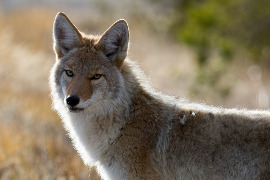 The warmer weather brings an increase in the wildlife population, as local animals come out of hibernation with their new offspring. In the Meaford and surrounding areas, sightings are reported daily; everything from foxes, to coyotes, bobcats, and more. While humans and wildlife generally coexist harmoniously, there will inevitably be run-ins that can be avoided with the right precautions.
The warmer weather brings an increase in the wildlife population, as local animals come out of hibernation with their new offspring. In the Meaford and surrounding areas, sightings are reported daily; everything from foxes, to coyotes, bobcats, and more. While humans and wildlife generally coexist harmoniously, there will inevitably be run-ins that can be avoided with the right precautions.
Remember, wild animals are still wild; they need to hunt and forage for their food. And they can’t differentiate between a potential meal and a domesticated pet. House cats and small dogs are particularly at risk to predators, so exercising extra caution is a must. Even though large dogs are typically not seen as prey by wildlife, there is always the risk of a confrontation which may result in injury.
Except in the case of rabid or injured animals, wild animals don’t usually attack pets for sport – they’re simply living their lives the way nature taught them. Urban development disrupts many natural wildlife habitats, forcing these animals to live in closer proximity to humans than normal.
The most effective way to keep your pet out of harm’s way is to avoid situations where your pet may encounter wildlife. This may sound like common sense, however it’s a little more complicated than simply staying out of the forest.
Keep Pets Leashed
While it is convenient to let your pet out for a romp in an enclosed backyard, it may make them easy targets for predators. Coyotes, for example, can clear a six-foot fence with ease. Raccoons and other small critters can climb over or dig under fences to gain entry to your yard. It is wise to stand in the yard to supervise your pet while they do their business – especially at night. Wildlife are far less inclined to attack when there is a human nearby, especially when the pet is on-leash.
Be Extra Vigilant at Night
Most encounters between pets and wildlife happen after sundown. With the benefit of night vision, many wild animals are nocturnal, and hunt primarily at night. Be extra cautious of your pet’s safety during this time, and maintain awareness of your surroundings.
If you enjoy evening walks, make sure you stay in a populated, well-lit area. And again, keep your pet on a leash. If possible, consider leaving your pet at home for their safety.
Don’t Bring Attention to Yourself, Your Pet, or Your Property
Decorative bells on your pet’s collar may be cute, however it makes them an easier target for hungry predators. Sound plays a primary role in the ability to track prey, and the sound of a bell invites curiosity to all in earshot.
Also, consider your garbage situation. If possible, keep your garbage in a lid-locked bin inside a shed or garage. If you must keep garbage outside, make sure is well secured. Raccoons, bears, and other unwanted wildlife are attracted to our waste, so try not to keep household garbage hanging around for long.
Finally, don’t unintentionally invite wild animals to hide around your property. For example, a turned over wheelbarrow, under a trailer, loose brush and yard waste make excellent hiding spots. By providing space for animals to hide, you’re inviting them closer to your home.
Living harmoniously with wild animals can be easy for pet owners if you follow these simple steps to avoid unwanted interaction. Stay alert, stay informed!
Brandon Forder – also known as The Pet Expert – is vice-president of Canadian Pet Connection, a family-owned and -operated business located in Meaford. He has over twenty years’ experience specializing in pet nutrition, behaviour, and healthy pet lifestyles. Canadian Pet Connection is an industry leader committed to providing their clients with the highest levels of personal, attentive service. Learn more at www.CanadianPetConnection.com.









